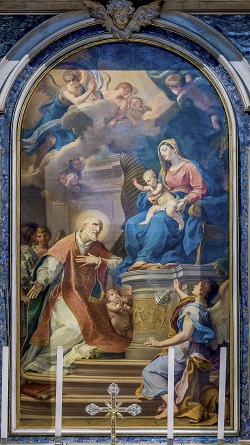Maurilio Lovatti
Saint Philip Neri kneeling before the Virgin Mary (1745) by Giacomo Zoboli
in the church of Santa Maria della Pace in Brescia
About ten years after the altarpiece on the main altar of the Duomo Nuovo, Giacomo Zoboli (1681-1767) created another Marian work for Brescia, this time featuring Saint Philip Neri as the protagonist. The painting was commissioned by the Congregation of the Philippine Fathers of Peace and placed in the second altar on the right of the church of Santa Maria della Pace in Brescia, where it is still located today. Saint Philip Neri Kneeling Before the Virgin is the Brescian painting by Zoboli about which we have the most detailed information. Among other things, the painter placed his signature and the date (1745) at the base of the first step on the right. The great success achieved by the altarpiece of the Assumption, induced a few years later the Philippine Fathers della Pace (a church in Brescia) to commission Zoboli to paint the most important painting of the church then under construction, the one dedicated to Saint Philip Neri, the founder of the Congregation of the Oratory of the Philippine Fathers. The first stone of the new church of Santa Maria della Pace had been laid on 15 September 1720 and the work had proceeded quite rapidly, for the times, and already in 1736 the dome was being built. In 1737 Cardinal Angelo Maria Querini donated to the church the altarpiece of the high altar, the Presentation of Jesus at the Temple, by Pompeo Batoni (1708-1787) born in Lucca, but also living and working in Rome. The Philippine Fathers, after an unsuccessful attempt to involve Sebastiano Conca, decided on 24 April 1742 to commission the altarpiece of the altar dedicated to Saint Philip Neri from Zoboli.
The painting, a large oil on canvas (447 by 223 cm), was created in Rome, specifically in Palazzo Farnese, where Zoboli lived and worked from 1738 to 1760. The fee was set at 300 ducats, later raised to 320. The painting was completed in June 1745 and arrived at the church of Pace in November of the same year. The painting features bright and vivid colors like that of the cathedral, but is characterized by a more intense luminosity, combined with colder and more delicate tones, probably aimed at enhancing the figure of Saint Philip Neri, founder of the Congregation, who appears in the foreground and at the center of the viewer's attention. The compositional scheme of the work is very successful: the positioning of the characters determines an evident effect of depth and an overall harmony.
The protagonists are depicted in profile, the Madonna and the Saint depicted in an architectural context of refined beauty. Their garments are meticulously painted: the saint's bright pink dalmatic, finely embroidered in gold, contrasts with a flowing white alb, trimmed at the edges with delicate lace. Zoboli also paid attention to the detail of the cushion on which the saint kneels, giving it a velvety effect and embellishing it with a golden tassel placed on the corner. Before him, seated on a throne, the Madonna bends slightly, intent on showing the baby Jesus to the Saint, who blesses him. Mary is depicted in a maternal gesture of protection, intent on covering the Child with her golden veil and small pure white sheet.
On the second level, beyond the plinth, a small angel holds a flaming heart on another cloth. The symbol of the "burning heart" alludes to the mystical episode experienced by the Saint in 1644, when he felt as if a globe of fire had penetrated his chest. It is precisely within the latter's visual circle that we find an angel, seen from behind, incensing the scene with a highly detailed silver thurible.
The base of the Virgin's throne features a depiction of King David, gazing heavenward, playing his lyre and dancing, likely in honor of the Ark of the Covenant. The biblical episode and the fact that David's gaze, in addition to the heavens, also appears to be directed at the two sacred figures above him, could allude to an ideal connection between the Old and New Testaments. It should be noted that Zoboli actively and enthusiastically participated for nearly fifty years in the meetings and activities of the Archconfraternity of the Sacred Stigmata of Saint Francis in Rome, where the Scriptures were read and meditated upon. The scene is framed by several ranks of angels; in particular, behind the Saint, one angel holds a white lily. On the steps, a book, presumably the Bible, with a cover similar to the saint's robe, is divided in half by a piece of paper, perhaps separating the Old Testament, symbolized by King David, from the New, with Jesus.
The Civic Museum of Ancient Art in Modena houses the preparatory model for the altarpiece (98 x 49.5), the only surviving example of several prototypes that Giacomo Zoboli had written to produce before proceeding with the painting for the Filippini church in Brescia. Beautiful and faithful, it features only slight variations from the final version, which omits the white lily on the steps at the feet of Saint Philip Neri and a second book, opened and leaning on top of the other.
Saint Philip Neri kneeling before the Virgin Mary by Giacomo Zoboli (1745)
Giacomo Zoboli and Cardinal Querini: Rome and Brescia in XVIII Century
Painting by Giacomo Zoboli in Rome, Modena, Brescia and in other locations (in italian)
Documents about death an burial of Giacomo Zoboli
- Giacomo Zoboli (1681-1767) Treccani -Dizionario biografico degli italiani (in italian)
- Giacomo Zoboli (1681-1767) Wikipedia
